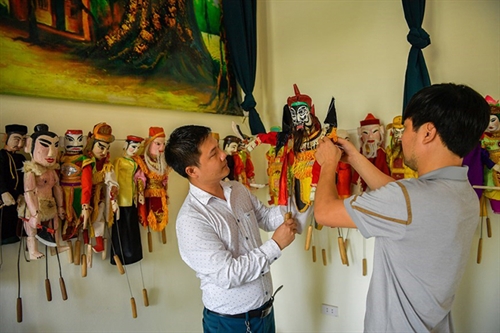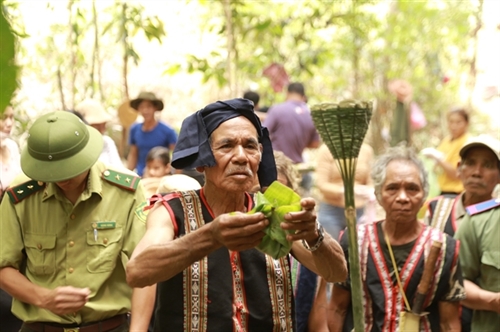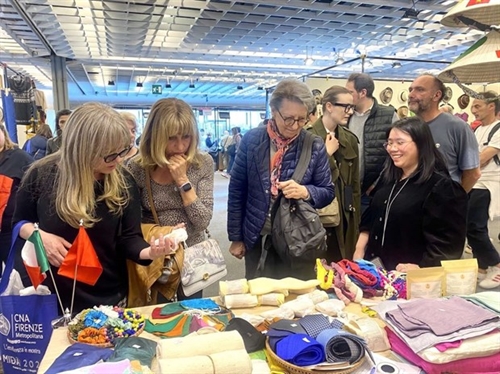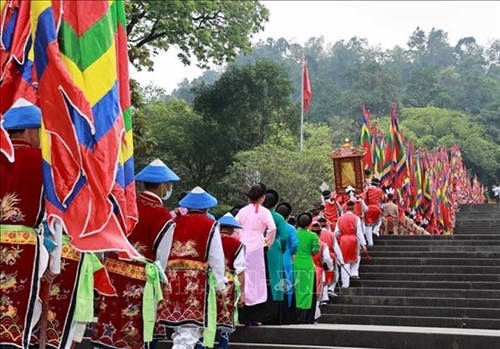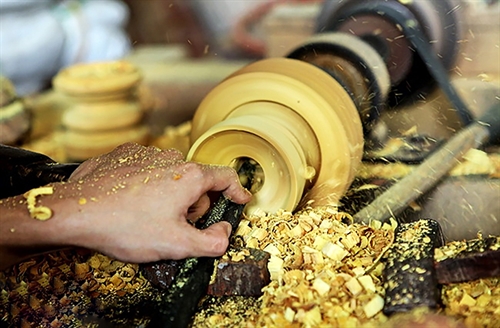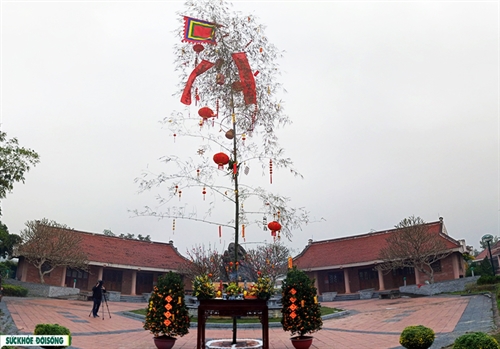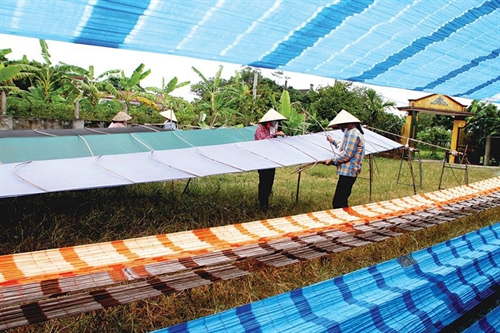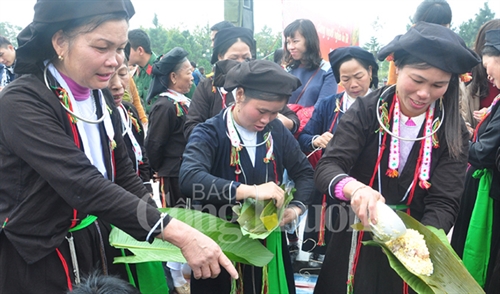For many villagers and households in Da Sy village, blacksmithing is not just a livelihood but a cultural feature and tradition passed down from generation to generation.
Located in Hanoi’s outlying Ha Dong district in the downstream area of the gentle Nhue river, Da Sy blacksmithing village can be easily found with sounds of steel and iron hamming and grinding from dawn to dark.
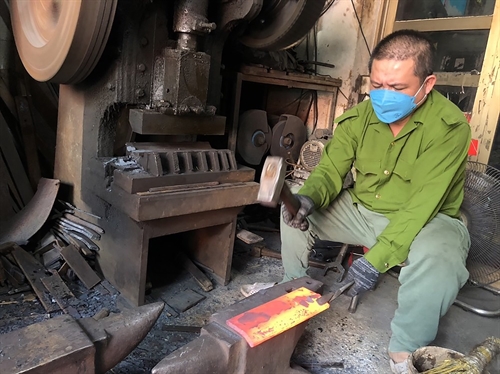 |
| A blacksmith flattens a knife blade by hammering out the flat edge of a red hot metal on an anvil__Photo: Vnbusiness.vn |
| A blacksmith flattens a knife blade by hammering out the flat edge of a red hot metal on an anvil__Photo: Vnbusiness.vn |
According to Chairman of the Da Sy Craft Village Association Hoang Quoc Chinh, Da Sy became to be known as a blacksmithing craft village in the late 16th or early 17th century. It was believed by villagers that two blacksmiths named Nguyen Thuat and Nguyen Thuan from the central province of Thanh Hoa had come to the village and taught blacksmithing techniques to locals. Every year, on the 27th of the third lunar month and the 25th of the eighth lunar month, the death anniversaries of Nguyen Thuat and Nguyen Thuan, villagers hold ceremonies to honor the two ancestors’ contributions to the craft village.
Through many ups and downs of historical development, Da Sy blacksmithing village has constantly developed and played an increasingly important role in the society. The village’s products, ranging from production tools such as hammers, chisels, saw blades, hoc blades, and shovel hoes to household utensils like cutlery of all kinds have been familiar to people all around the country.
The period from 1990 to 2010 can be considered the “golden age” of the blacksmith during which the village witnessed a sharp increase in the number of production households and strong improvement in the quality and design of products, helping increase income of and bring prosperous life for the villagers.
Special blacksmithing techniques of Da Sy villagers
Today many of the production processes have been mechanized but just about 10 years ago, all products of Da Sy village were handmade. Thanks to the villagers’ mastery of the metal tempering and blading techniques, their products, especially cutlery, are appreciated for their sharpness and durability.
To produce a knife, craftsmen, first of all, split a flat steel bar into the rough shape of a knife blade as designed, and then put it on a coal furnace with a temperature of nearly 1,000 degree Celsius where it will be burnt for a period of time which varies depending on the type of the iron/steel and the thickness of the product.
When the metal pierce glows reddish, it is put on an anvil for forging until it has the shape of a knife blade as designed. This job is usually performed by young men who must be strong enough to make fast and heavy hammering. Then the hot blade is soaked in cold water for just a few seconds, or even a tenth of a second. This step, which is known as quenching, will harden the steel.
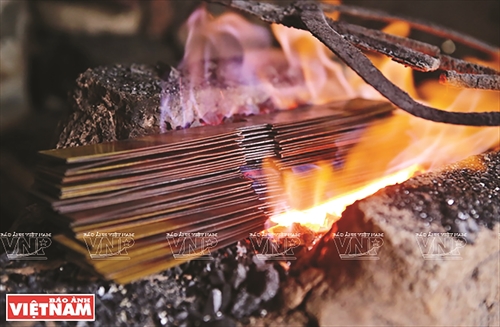 |
| Heat treating is an important blacksmithing technique__Photo: https://vietnam.vnanet.vn/ |
| Heat treating is an important blacksmithing technique__Photo: https://vietnam.vnanet.vn/ |
In the next step, craftsmen cut off all excesses on the surface of the blade, put it again into the coal furnace until it turns red, and then once again dip it in cold water or oil.
After the quenching step, craftsmen flatten the blade by grinding straight down along the blade at an angle of 45 degrees so as to make the blade evenly thin and sharp. This is a difficult job which requires fine workmanship and, therefore, is often performed by skilled craftsmen. The following steps, including wet grinding, coloring, abolishing, oiling and handle fitting, are usually done by women and junior workers as they require dexterity rather than strength.
According to Nguyen Hong Phan, the fifth-generation craftsman in a blacksmith family in Da Sy village, the village’s cutleries are very durable thanks to technical know-hows. “The tempering and blading techniques are not taught in any books but passed down in family from generation to generation,” Phan said in an interview with VOV.
As revealed by artisan Dinh Cong Doan, deputy chairman of the Da Sy Craft Village Association, blacksmithing is the main livelihood of approximately 80 percent of households in the village. Each family has its own secrets and specializes in one type of product. The village has around 20 master craftsmen who can satisfy any request of customers.
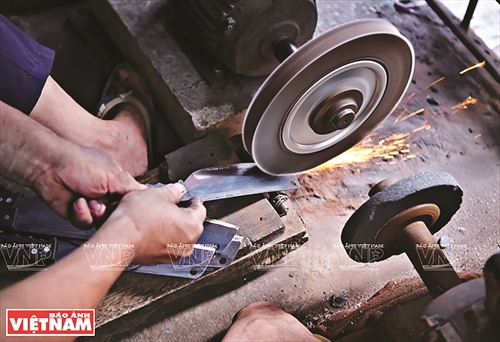 |
| Grinding knife blades__Photo: https://vietnam.vnanet.vn/ |
Adapting to modern production in tandem with upholding traditional values
At present, Da Sy village has around 1,200 households engaged in the business, supplying about 450 to 500 tons of products of all kinds to the market with annual revenues exceeding VND 200 billion (USD 8.7 milion). The average monthly income of a worker is VND 7-10 million (USD 300-430).
Since 2011, the village has encountered several challenges. The demand for some of its major products, for example, wood-working tools like poles, planers and chisels, has reduced due to the emergence of modern machines. Meanwhile, more and more people, especially city dwellers, seem to prefer stainless steel knives and scissors imported from Thailand, China and Japan.
To deal with the situation, Da Sy village needs to transform itself, focusing on specialization, modernization, and application of new technologies to production in order to improve its productivity as well as the quality of blacksmithing products. Noteworthily, a project on building a cottage industry park with an area of 13.2 ha has been formulated and submitted to authorities for approval, aiming to mitigate environmental pollution and create favorable conditions for villagers to apply science and technology into production.
Besides, the development of the craft village must be in tandem with tourism development to promote production development and create more jobs for local people. In light of this, Da Sy villagers will cooperate with travel agencies to develop craft village tourism models to attract more domestic and foreign visitors.
Da Sy village has been officially recognized by the Vietnam Association of Craft Villages as one of the country’s typical traditional craft villages.-
